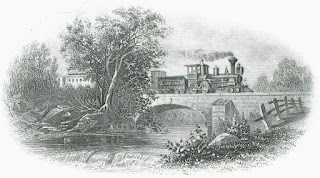Question sent by D.P. via email on July 19, 2015 after he had contributed scans of several certificates for listing in the database. His inquiry concerned a small inscription he found on the left side of a bond from the Atchison Topeka & Santa Fe Railroad (shown below.)
Question on the ATSF one. I noticed a slight difference between this one that I just sent and one that I had sent previously. The most recent one has a completed stamp, "This bond bears interest from" along with a stamped date and the other one has a printed "This bond bears interest from" and a printed 189_. Would this be enough to qualify as a different variety or is the variation too small to consider?
My answer ----------
This gets into a gray area. In your case, I did create a new sub-variety.
Deciding whether to create new listings is sometimes very difficult. There is often no easy answer and I fight this battle EVERY time someone reports new and minor variations.
It is
hard to create a fail-proof system for deciding what variations to consider as sub-varieties and which ones will fail. In
general, I usually ask a series of six questions. In order to qualify as a new
variety or sub-variety number, a new variation must receive three (preferrably four)
positive answers.
1
Is
the variation visible on the front of the document?
2
Are
we able to spot the variation in average images we see online or in catalogs?
3
Are
there any price ramifications of the newly-reported variation?
4
Are
the majority of today’s collectors likely to care about the observed variation?
5
Was
the original plate altered to print the variation?
6
Would
the alteration have had any effect on the investment characteristics of the security?
Questions
1 and 2 are my most important considerations. “No” to either of these questions
kills the deal. Collectors must be able to see and identify variations easily. Period.
End of story. No exceptions.
Question
3 is obviously important. If a variation affects price, it definitely gets a
new catalog number. However, in the interest of realism, the minor variations we
spot on certificates ALMOST NEVER affect prices. Granted, they might affect
prices in the future, but not right now. The answer to this question is
usually, “No.”
Question
4 is almost as important, but again the answer is usually “No.” In my
experience, average collectors never care about minor variations until they find something new for themselves and want to report it. I think we all enjoy finding features that
everyone else missed, no matter how small. It is like treasure hunting and
panning for gold. Discovery is a distinct pleasure offered by every collecting
hobby. Never mind that our discoveries probably have no monetary significance.
Question
5 is one of my original requirements for determining “varieties.” If variations were not part of original document printings, I am hesitant to create new listings.
Question
6 is my final filter and is highly important. If any variation changed
ANY feature that an original investor might have cared about, then it almost always gets a
new catalog listing. For instance, if the capitalization of a stock certificate was changed
by hand, then that minor maneuver would have changed the
perceived value of that company’s entire stock offering. If a rubber-stamped
impression extended the redemption date of a bond, then an investor would
almost certainly have perceived a decrease in the bond’s value.
You
spotted a variation in the 1889 general mortgage bond issue of the Atchison
Topeka & Santa Fe Railroad. At first look, the variation seems terribly
minor and not worth wasting time on.
From a corporate perspective, that little one-line alteration actually represented the discovery of a mistake that could have proved very costly to the AT&SF. No doubt, the mistake originated with the person or committee who composed the text of the bond.
From a corporate perspective, that little one-line alteration actually represented the discovery of a mistake that could have proved very costly to the AT&SF. No doubt, the mistake originated with the person or committee who composed the text of the bond.
This is
a registered bond. It SHOULD have been printed with a space for the issue date.
Instead, it carried a static issue date of July 1, 1889. THAT oversight was the mistake.
By not indicating a variable issue date, the bond mistakenly indicated that interest would have been paid from July 1, 1889 instead of its actual issuance date. In other words, had a particular bond not been sold until July 1, 1890, the company legally would have been obligated to pay an extra $40 in interest on a $1000 bond or $200 on a $5,000 bond. It appears the company caught the mistake in 1889 and quickly added rubber stamp notices to the left side of its bonds. The company added printed notices when it reprinted $1000 and $5000 bonds in the early 1890s.
By not indicating a variable issue date, the bond mistakenly indicated that interest would have been paid from July 1, 1889 instead of its actual issuance date. In other words, had a particular bond not been sold until July 1, 1890, the company legally would have been obligated to pay an extra $40 in interest on a $1000 bond or $200 on a $5,000 bond. It appears the company caught the mistake in 1889 and quickly added rubber stamp notices to the left side of its bonds. The company added printed notices when it reprinted $1000 and $5000 bonds in the early 1890s.
I cannot tell exactly how large this particular bond issue was. It seems to have been
authorized for around $175 million to pay off its costs of corporate reorganization in
1894. The dates on the bonds in my database suggest the issue did not sell
particularly well. Had the company not caught the mistake and had only 25% of
the bond issue remained unsold until July 1, 1890, the mistake would have totaled
$1.75 million.
An aside ---------
The AT&SF issued its registered general mortgage bonds of 1889 in five denominations. Prior to this new report, there were five variety numbers for this bond issue. With the new discovery, I added "a" and "b" to variety numbers to indicate the different variations of rubber-stamped and printed inscription. A single $500 specimen is known that lacks the inscription shown above. All the rest show some form of the crucial inscription. No printed variants of the $500, $10,000 and $50,000 have been reported yet.
An aside ---------
The AT&SF issued its registered general mortgage bonds of 1889 in five denominations. Prior to this new report, there were five variety numbers for this bond issue. With the new discovery, I added "a" and "b" to variety numbers to indicate the different variations of rubber-stamped and printed inscription. A single $500 specimen is known that lacks the inscription shown above. All the rest show some form of the crucial inscription. No printed variants of the $500, $10,000 and $50,000 have been reported yet.
| $500 | B-30 | no inscription at left |
| B-30a | rubber-stamped inscription at left | |
| $1,000 | B-31a | rubber-stamped inscription at left |
| B-31b | printed inscription at left | |
| $5,000 | B-32a | rubber-stamped inscription at left |
| B-32b | printed inscription at left | |
| $10,000 | B-33a | rubber-stamped inscription at left |
| $50,000 | B-34a | rubber-stamped inscription at left |









